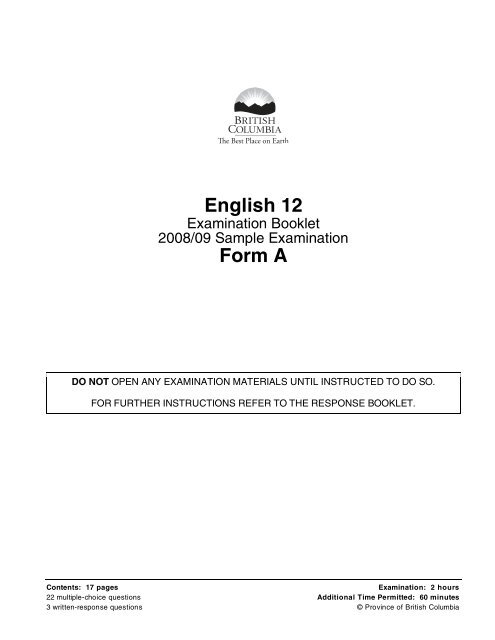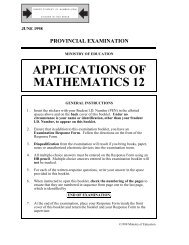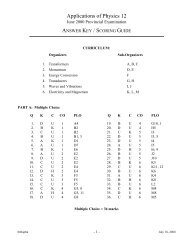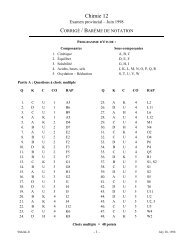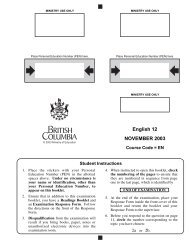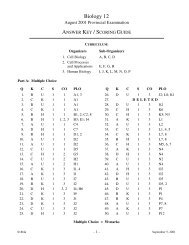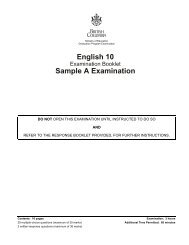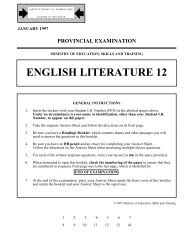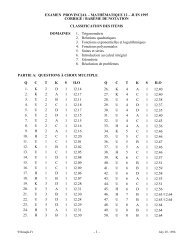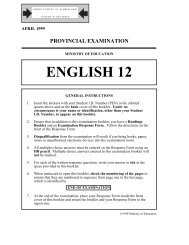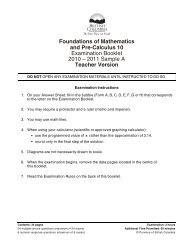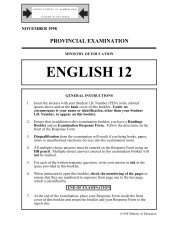English 12 Form A - QuestionBank.CA
English 12 Form A - QuestionBank.CA
English 12 Form A - QuestionBank.CA
You also want an ePaper? Increase the reach of your titles
YUMPU automatically turns print PDFs into web optimized ePapers that Google loves.
<strong>English</strong> <strong>12</strong>Examination Booklet2008/09 Sample Examination<strong>Form</strong> ADO NOT OPEN ANY EXAMINATION MATERIALS UNTIL INSTRUCTED TO DO SO.FOR FURTHER INSTRUCTIONS REFER TO THE RESPONSE BOOKLET.Contents: 17 pagesExamination: 2 hours22 multiple-choice questions Additional Time Permitted: 60 minutes3 written-response questions © Province of British Columbia
You have Examination Booklet <strong>Form</strong> A. In the box above #1 on your Answer Sheet, fill in thebubble as follows.Exam Booklet <strong>Form</strong>/Cahier d’examenA B C D E F G H<strong>English</strong> <strong>12</strong> – 2008/09 Sample Examination Page 1
PART A: READING COMPREHENSIONSTAND-ALONE TEXT7 multiple-choice questions Suggested Time: 25 minutes1 written-response questionValue: 23%INSTRUCTIONS: Read the following passage, “An Ode to the User-Friendly Pencil,” and answer themultiple-choice questions. For each question, select the best answer and record yourchoice on the Answer Sheet provided.adapted from An Ode to the User-Friendly Pencilby Bonnie Laing1 Recently I acquired a computer. Or perhaps I should say it acquired me. My therapist claims thatacknowledging the superior partner in a destructive relationship is the first step toward recovery. Ishould point out that prior to this acquisition, my idea of modern technology at its best was frozenwaffles. My mastery of business machines had advanced only as far as the stapler.2 I was persuaded to make this investment by well-meaning friends who said the word-processingcapacity of a computer would make me a better writer, make me a more productive writer, and make mea richer writer. I pointed out that Chaucer was a pretty good writer even though he used a quill, andDickens managed to produce 15 novels and numerous collections of short stories without so much as atypewriter. But I have to admit that option C got to me, even if I couldn’t figure out how spending$3,000 on a piece of molded plastic was going to make me wealthier.3 To date, my association with the computer has not been too successful. It has proven to be verysensitive to everything but my needs. At the last breakdown (its, not mine) the service man commentedthat it should have been called an Edsel, 1 not an Epson, and suggested an exorcist be consulted.Needless to say, I am not yet in a position to open a numbered Swiss bank account.4 But they say hardship teaches you who your friends are. And so, my computer experience has forcedme to spend a lot more time with an old friend, the pencil. Its directness and simplicity have proven tobe refreshing. In fact, the more I wrestled with my microchips (whatever they are), the more convincedI became that the pencil is superior to the computer. Allow me to cite a few examples.5 To start with the purchase decision, you don’t have to ask for a bank loan to buy a pencil. Since mostpencils are not manufactured in Japan, you don’t feel you’re upsetting the nation’s balance of trade bybuying one.6 In fact, pencils are constructed in part from that most Canadian of natural resources — wood. Bybuying pencils you create employment and prosperity for dozens of people in British Columbia. Well,a few anyway.7 Of course, like most people I rarely buy a pencil, preferring to pick them up free from various places ofemployment, in the mistaken belief that they are a legitimate fringe benefit. It’s best not to make thatassumption about office computers.1 Edsel: an unreliable carPage 2<strong>English</strong> <strong>12</strong> – 2008/09 Sample Examination
8 Operationally, the pencil wins over the computer hands down. You can learn to use a pencil in lessthan 10 seconds. Personally, at the age of 2, I mastered the technology in 3.2 seconds. To be fair,erasing did take a further 2.4 seconds. I’ve never had to boot a pencil, to interface with it or to programit. I just write with it.9 Compared to a computer, a pencil takes up far less space on a desk and it can be utilized in a car,bathroom or a telephone booth without the aid of batteries. You can even use one during an electricalstorm. Pencils don’t cause eye strain and no one has ever screamed, after four hours of creativeendeavour, “The - - - - pencil ate my story!”10 Pencils are wonderfully single-minded. They aren’t used to open car doors, make the morning coffeeor remind you that your Visa payment is overdue. They’re user-friendly. (For the uninitiated, seecomments on vocabulary.)11 Of course, the technologically addicted among you will argue that the options of a pencil are ratherlimited. But the software of a pencil is both cheap and simple, consisting of a small rubber tip located atone end of the unit. A pencil is capable of producing more fonts or typefaces than any word processor,depending on the operator’s skill.<strong>12</strong> Its graphic capability is limited only by the operator’s talent, an element referred to as the Dürer 2 or DaVinci Factor. Backup to a pencil can usually be found in your purse or pocket. Although a pencil hasno memory, many of us who write badly consider that to be an advantage.13 But it’s in the area of maintenance that the pencil really proves its superiority. Should a pencil breakdown, all you have to do to render it operational again, is buy a small plastic device enclosing a sharpmetal strip, a purchase that can be made for under a dollar. A paring knife, a piece of broken glass oreven your teeth can be used in an emergency. For the more technically advanced, an electronic pencilsharpener can be obtained, but I should point out that these devices don’t run on electrical power but bydevouring one-third of the pencil.14 You never have to take a pencil to a service department located on an industrial site on the outskirts ofMoose Factory. Neither do you have to do without them for two weeks before discovering that themalfunction is not covered by the warranty and that the replacement part is on a boat from Korea.15 What finally won me over to the pencil was its lack of social pretension. For instance, very few peoplesuffer the nagging doubt that their intelligence is below that of a pencil. No one has ever claimed that apencil put them out of a job. And the pencil has not created a whole new class of workers whoconsider themselves superior to, let’s say, crayon operators. At parties, you meet very few people whowill discuss pencils with a fervour normally found only at student rallies in Tehran. Fewer peopleboast about being ‘pencil literate.’16 Of course, the pencil is not without its flaws. It has a nasty habit of hiding when most needed.If located beside a telephone, it will break spontaneously if a caller wishes to leave a message. Thoseaspiring to be professional writers should note that editors are unreasonably prejudiced againstsubmissions in pencil.17 But a pencil won’t argue with you if you wish to write more than 50 lines to the page. It won’t insiston correcting your whimsical use of grammar, and it won’t be obsolete 10 seconds after you mortgageyour first-born to buy one. Just in case you remain unconvinced, I ask you, can you imagine chewingon a computer while balancing your cheque book? And what do computer operators use to scratch thatplace in the middle of the back where they can’t reach? The defence rests.2 Dürer: a famous European artist<strong>English</strong> <strong>12</strong> – 2008/09 Sample Examination Page 3
Figure 1www.cartoonbank.com1. Which stylistic device is used in the title, “An Ode to the User-Friendly Pencil”?A. punB. clichéC. euphemismD. archaic language2. Which technique is used in paragraph 2?A. parableB. allusionC. allegoryD. archaismPage 4<strong>English</strong> <strong>12</strong> – 2008/09 Sample Examination
3. What main purpose is served by paragraph 1?A. to encourage people to buy a computerB. to establish the objectivity of the writerC. to engage the reader’s interest with the topicD. to assess the advantages of modern technology4. Which method of development is primarily used in the article?A. expert opinionB. cause and effectC. chronological orderD. compare and contrast5. Which quotation best expresses the main idea of the article?A. “To date, my association with the computer has not been too successful” (paragraph 3)B. “Operationally, the pencil wins over the computer hands down” (paragraph 8)C. “Pencils are wonderfully single-minded” (paragraph 10)D. “the technologically addicted among you will argue that the options of a pencil are rather limited”(paragraph 11)6. What is the tone of the article?A. satiricB. humbleC. resignedD. nostalgic7. With reference to Figure 1, what is the basis of the humour in the cartoon?A. caricatureB. faulty logicC. stereotypingD. juxtaposition<strong>English</strong> <strong>12</strong> – 2008/09 Sample Examination Page 5
INSTRUCTIONS: In paragraph form and in at least 150 words, answer question 1 in the ResponseBooklet. Write in ink. Use the Organization and Planning space to plan yourwork. The mark for your answer will be based on the appropriateness of theexamples you use as well as the adequacy of your explanation and the quality of yourwritten expression.1. In paragraph form, and with specific reference to “An Ode to a User-Friendly Pencil,” discuss ironyin the article.Organization and PlanningUse this space to plan your ideas before writing in the Response Booklet.WRITING ON THIS PAGE WILL NOT BE MARKEDPage 6<strong>English</strong> <strong>12</strong> – 2008/09 Sample Examination
PART B: READING COMPREHENSION13 multiple-choice questions Suggested Time: 25 minutesValue: 16%SYNTHESIS TEXT 1INSTRUCTIONS: Read the following poem, “Wordsmith,” and answer the multiple-choice questions.For each question, select the best answer and record your choice on the AnswerSheet provided.15WordsmithIn my mind I call myfather the Pollyfilla 1 king,watch with something akin to aweas he begins the arduous processof filling in the gaps, the long windedcracks that travel down the walls of my houselike run on sentences.by Susan Young10From the sidelines I watch as hetrudges up and down the stairs, carryingwith nonchalance an industrial-sized bucket,shiny spatula tucked into back pocketfor easy access.15202530Over and over againwith precision and gracehe fills and smooths and sandsas filling in all of the empty creviceswith the words he didn’t know how to say,the lost syllables and consonants springing upfrom the bucket, stubbornly announcing themselveshome, until there is only smoothness,my fifty eight year old house a perfect sentence,the veritable sheen of its wallsprivy to this father of mine,whose love keeps him movingfrom room to room, brightly asking,Do you think you’ll be painting the other roomupstairs sometime? I could start work on it now.Then it’ll be ready for painting later.Yes, I say, yes,my face aglow.1 Pollyfilla: a brand name for a substance used to fill cracks in plaster walls<strong>English</strong> <strong>12</strong> – 2008/09 Sample Examination Page 7
8. What does “arduous” (line 4) suggest about the task of repairing the house?A. It was simple.B. It was difficult.C. It was annoying.D. It was overwhelming.9. What is the purpose of the italics used in lines 26–29?A. to indicate speechB. to provide emphasisC. to serve as an epilogueD. to foreshadow future events10. Which statement best describes the character of the father?A. He has high expectations of his children.B. He provides a good role model for his children.C. He shows more caring for his house than his family.D. He demonstrates his love for his family through his work.11. Which literary device is primarily used in the poem?A. paradoxB. internal rhymeC. personificationD. extended metaphor<strong>12</strong>. Which word best describes the overall mood of the poem?A. solemnB. regretfulC. nostalgicD. whimsical13. What is the form of the poem?A. balladB. sonnetC. free verseD. blank versePage 8<strong>English</strong> <strong>12</strong> – 2008/09 Sample Examination
SYNTHESIS TEXT 2INSTRUCTIONS: Read the following excerpt from “The Gold Mountain Coat,” and answer themultiple-choice questions. For each question, select the best answer and record yourchoice on the Answer Sheet provided.The narrator remembers her childhood in small-town Ontario during the 1950s.“Gold Mountain” is the name by which many Chinese referred to North America.The Gold Mountain Coatby Judy Fong-Bates1 The small town that was my home was typical of many small towns in Ontario. It had one main street,one elementary school, one district high school, and five churches – Presbyterian, Anglican, United,Roman Catholic, and a Dutch Reform Church on the edge of town.2 The main street of our small town had a dime store that sold everything from Evening in Paris perfumeto stationery and hammers. It also had a clothing store, a jewellery shop, a hardware store, a drugstore,a barber shop, and a restaurant that served Canadian food. And, typical of all small towns, it also had aChinese restaurant and a Chinese hand laundry.3 My father operated the hand laundry and the other Chinese family managed the Chinese restaurant.I was the only Chinese child in the town. When my family first arrived, the restaurant was run by twobrothers and their father, Sam Sing. The floors were covered with old-fashioned black and red linotiles laid out in a diamond checkerboard pattern. There was a shiny speckled <strong>Form</strong>ica counter withstools of circular seats upholstered in vinyl, and rimmed with a wide band of shiny chrome. Therehung from the ceiling, a huge, four-blade fan, that in the summer hovered and whirred – a hugehumming dragonfly.4 The proprietor, Sam Sing, stood behind the counter of his restaurant. He was a tall, straight-backed,grim-looking man with deep wrinkles cross-hatching his face. Sam rarely smiled, but when he did heshowed a set of gold teeth that matched his gold-rimmed glasses. He rarely spoke, but when he did hisvoice had the raspy quality of sandpapers rubbing together.5 There was nothing ingratiating about Sam. He glared at his customers from behind his glasses. In hispresence, I was always struck speechless. I was afraid to return his gaze. I felt diminished andinsignificant.6 When I first met Sam Sing, he was already in his seventies; he had a head of thick, almost totally blackhair parted at the side. He seemed robust and alert, and for a man his age he moved with amazingagility. My parents told me that Sam owed his exceptionally good health to drinking medicinal turtlesoup. According to local legend, whenever Sam felt unwell, he asked a couple of local teenage boys tocatch him a turtle from the nearby creek. Then followed hours of simmering to produce a clear, brown,pungent, tonic soup.<strong>English</strong> <strong>12</strong> – 2008/09 Sample Examination Page 9
7 Sam was proud of the fact that he had fathered two sons who would carry on his business and hisfamily name. In contrast to Sam’s stern, imposing demeanour, his sons were round-faced, smoothskinned,and smiling. They reminded me of bookends; they looked almost identical, except thatone was very fair-skinned, while the other was very dark.8 The brothers, Ken and John, were kind to me. I remember visiting the restaurant and frequentlycoming out with a double-scooped ice cream cone. Often the brothers came to visit my parents inthe afternoon, during the quiet time between the lunch and supper hours in the restaurant. But SamSing never entered our house. His enterprise was prosperous, whereas ours was poor. Did he feelthat we were beneath him? Or was it that we reminded him of earlier and more meagre times thatwere best forgotten?9 What I remember most about Ken and John, though, was that in the winter they visited our houseone at a time. Between them, they shared a single coat. It was a shapeless, black, wool garment.The pile was completely worn, the sleeves were permanently accordioned, the buttons were allmismatched, and the corners of the collar curled upwards. Occasionally, when the weather was nottoo severe, one brother would arrive at the laundry dressed in the coat. A half hour or so later theother brother would dash over wearing just a thin sweater over his white shirt. This made my motherlaugh and she teased them about their excessive thrift.10 For many years, Sam Sing and his sons lived contentedly in this bachelor existence. The sons eachhad a clearly defined role in the running of the restaurant and Sam presided over everything. Kenhad come to Canada unmarried, but John had left his wife, son, and daughter back in China. Afterworking through government channels for several years, John was finally given permission to bringhis family over.11 My mother often helped John compose his letters back to China. Whenever he received mail fromhome, he rushed over to share it with my parents. One day he showed me a picture, taken in a studio,of his wife, son, and daughter. The wife and daughter had freshly permed hairstyles parted at the side,revealing high broad foreheads. The son was dressed in too-large overalls, the bib almost touching hischin. The mother was sitting down with her hand resting on her son’s shoulder, while the daughter,who was a few years older, stood slightly but noticeably apart. I looked at this picture and felt thesolemnity of their stares. It seemed strange to me that John was really the father. His youth andexuberance were in such contrast to the personality of my own father, who was over sixty when I wasborn. My mother was pleased that I would at last have Chinese playmates. Although both my parentswere proud that I had learned <strong>English</strong> so quickly, I knew they were concerned that I was becoming“too Canadian.” John told me that I would be in charge of teaching his children <strong>English</strong> and takingthem to school. As he spoke, the brown in his eyes took on a liquid quality and his eyebrows werearched so that dark vertical furrows appeared between them. Once more, I looked at the children in thephotograph. Then I looked at John. Did he expect me to be friends with them? I was the only Chinesechild in the town and since coming to Canada I had only played with lo fon 1 children. Did thesechildren from China know about Howdy Doody and Captain Kangaroo 2 ? What would I have toteach them besides <strong>English</strong>? I began to feel a weight on my chest.<strong>12</strong> When an arrival date for John’s family was established, Sam permitted his sons to close the restaurantfor a half-day. Both brothers were to go to the airport to greet the family from China. The brothers1 lo fon: caucasian2 Howdy Doody and Captain Kangaroo: 1950s children’s TV showsPage 10<strong>English</strong> <strong>12</strong> – 2008/09 Sample Examination
ecognized their father’s generosity in giving them a half-day off. For five years, the restaurant hadnever been closed. However, there was one problem. It was winter and they had only the one coat toshare between them. Both John and Ken realized that a new coat was a significant purchase, one thatwould have to have Sam’s approval. As the arrival date of John’s family drew nearer, and thetemperatures grew colder, the need for a second coat was becoming urgent.13 John and Ken discussed the purchase of a second coat from every angle. How could they convince theold man to part with enough money for a new coat? Timing was essential. After closing time, Ken andJohn always scurried around the restaurant. They swept and washed the floors, filled the glass sugardispensers and the miniature china creamers, and cleaned up the dirty dishes. Meanwhile, Sam satalone in the wooden booth at back of the restaurant. He carefully calculated the day’s profits, hisfingers flying over the rings of a black wooden abacus 3 brought many years ago from China. If theearnings were good, Sam invited his sons to share a glass of whisky. But if the earnings were poor,Sam drank alone and glowered at the wooden walls of the booth while his sons continued silentlyworking. Naturally, John and Ken decided to approach Sam on a night the whisky was shared.14 The day after his discussion with Ken, John came to visit my parents. Though I heard him chucklingas he confided to my mother about the logistics of the timing, every word was coated with resentment.At first he decided that Saturday should be the asking day. But then my mother pointed out that ifpermission to purchase was granted on a Saturday night, Sam might change his mind by the time storesopened on Monday. She convinced John that Friday was a better day. Business was usually good.And the stores were open on Saturday.15 On the chosen Friday, John visited us late in the afternoon. The wind sounded particularly shrillthat day as it sprayed blasts of white powdery snow over the sidewalks. When John walked intothe laundry, he looked as if someone had dusted him with icing sugar. He seemed quite agitated.I remember hearing him speak with great determination. “In a few days my family will be here. We’llall be living upstairs. I will be the one responsible for them.” He glanced at my mother who nodded inagreement. “I’m going to have to stand up to that old man. I carry all his money in my pocket.” Hepatted the front pocket of his pants emphatically before continuing. “And I have to ask permission tospend it. What right does he have to object? I work hard. This isn’t China. Things are different here.”Again, my parents said very little. They mostly smiled and nodded reassuringly. Then John suddenlyremembered, “Today is payday at the mill!” He smiled and exclaimed, “Today business will be good.Guaranteed!”16 Just before he left, John walked over to the corner where I sat pretending to read a comic book. Hepatted me on the shoulder and grinned. “Not too much longer now.” I looked up and smiled. Johnlooked so happy. As I nodded I felt an ever so slight cramp in my stomach.17 That Friday, after the restaurant closed, Sam counted his money, smiled, and invited his sons for aglass of whisky. This was the moment John had been waiting for. His father offered him a glass.He took a large, quick gulp. “Father, you know that my wife and family will be arriving onWednesday. You have been generous enough to let Ken come with me to the airport to greet them.”Sam nodded his head.3 abacus: manual calculating device<strong>English</strong> <strong>12</strong> – 2008/09 Sample Examination Page 11
18 John continued, with Ken nervously looking on. “But, Father, we have only one coat. The weatheris very cold. We need to buy another coat.”19 Sam carefully set down his whisky glass. His face slowly hardened at the boldness of his son’srequest. John was ready to panic but then Ken blurted out, “John’s son will need a coat for school.Your grandson cannot walk to school without a coat. A second one for us, one the boy can grow into.”20 Sam’s face broke into a smile. His gold teeth gleamed. “Very good,” he said and finished his whisky.The brothers breathed a sigh of relief.14. Which word best describes the small town where the narrator grew up (paragraphs 1–3)?A. isolatedB. run-downC. progressiveD. commonplace15. Which device is used in paragraph 3?A. pathosB. imageryC. dilemmaD. hyperbole16. Which phrase best expresses the narrator’s feeling about the arrival of “Chinese playmates”?A. uneasy about her new responsibilityB. unsure of her ability to teach <strong>English</strong>C. reluctant to share the adults’ attentionD. embarrassed about her loss of traditional culture17. Why do Ken and John choose Friday as the best day to ask their father’s permissionto buy the coat (paragraph 14)?A. The business would be quiet.B. The shops would be closed on Saturday.C. The father would be working with the accounts.D. The father would have little time to change his mind.Page <strong>12</strong><strong>English</strong> <strong>12</strong> – 2008/09 Sample Examination
18. Why does Ken’s argument convince his father to purchase a second coat?A. It appeals to his father’s caring nature.B. It appeals to his father’s sense of practicality.C. It reminds his father how hard the sons work.D. It reminds his father of the harshness of an Ontario winter.19. Which term best describes the narrator?A. generousB. observantC. dependentD. unquestioning20. What is the primary effect of the author’s use of a small town setting?A. It develops internal conflict.B. It develops a suspenseful mood.C. It emphasizes the prejudice of the people in the town.D. It emphasizes the uniqueness of the Chinese families.<strong>English</strong> <strong>12</strong> – 2008/09 Sample Examination Page 13
PART C: READING COMPREHENSIONANALYSIS OF SYNTHESIS TEXTS 1 AND 22 multiple-choice questions Suggested Time: 35 minutes1 written-response questionValue: 31%Multiple-choice questions 21 and 22 and written-response question 2 are based on the poem “Wordsmith”and the literary prose passage “The Gold Mountain Coat.”21. What do the speaker in “Wordsmith” and the narrator in “The Gold Mountain Coat” have in common?A. They are grateful.B. They are objective.C. They are respectful.D. They are protective.22. What causes the emotional response at the end of “Wordsmith” and “The Gold Mountain Coat”?A. hope for a promising futureB. pride in open communicationC. affirmation of parental supportD. successful completion of a projectYou have Examination Booklet <strong>Form</strong> A. In the box above #1 on your Answer Sheet, ensure youfilled in the bubble as follows.Exam Booklet <strong>Form</strong>/Cahier d’examenA B C D E F G HPage 14<strong>English</strong> <strong>12</strong> – 2008/09 Sample Examination
INSTRUCTIONS: In a multi-paragraph (3 or more paragraphs) essay of at least 300 words, answerquestion 2 in the Response Booklet. Write in ink. Use the Organization andPlanning space to plan your work. The mark for your answer will be basedon the appropriateness of the examples you use as well as the adequacy of yourexplanation and the quality of your written expression.2. Contrast the relationships that the father in “Wordsmith” and Sam Sing in “The Gold Mountain Coat”have with their children. You must refer to both passages in your essay.Organization and PlanningUse this space to plan your ideas before writing in the Response Booklet.WRITING ON THIS PAGE WILL NOT BE MARKED<strong>English</strong> <strong>12</strong> – 2008/09 Sample Examination Page 15
PART D: COMPOSITION1 written-response question Suggested Time: 35 minutesValue: 30%INSTRUCTIONS: Using standard <strong>English</strong>, write in the Response Booklet, a coherent, unified,multi-paragraph (3 or more paragraphs) composition of at least 300 words onthe topic below. In your composition, you may apply any appropriate methodof development including exposition, persuasion, description, and narration.Use the Organization and Planning space to plan your work.3. Write a multi-paragraph composition on the topic below. In addressing the topic, consider allpossibilities. You may draw support from the experiences of others or from any aspect of your life:your reading and your experiences. You do not have to accept the basic premise of the topic.Topic:Each generation has something valuable to offer.Organization and PlanningUse this space to plan your ideas before writing in the Response Booklet.WRITING ON THIS PAGE WILL NOT BE MARKEDEND OF EXAMINATIONPage 16<strong>English</strong> <strong>12</strong> – 2008/09 Sample Examination
ACKNOWLEDGEMENTSFong-Bates, Judy. “The Gold Mountain Coat.” From China Dog and Other Tales from aChinese Laundry. Sister Vision. 1997.Lang, Bonnie. “An Ode to the User-Friendly Pencil.” The Act of Writing: Canadian Essaysfor Composition. 1990.Young, Susan. “Wordsmith.” Chasing Halley’s Comet. Laughing Willow Books. 1995.<strong>English</strong> <strong>12</strong> – 2008/09 Sample Examination Page 17


